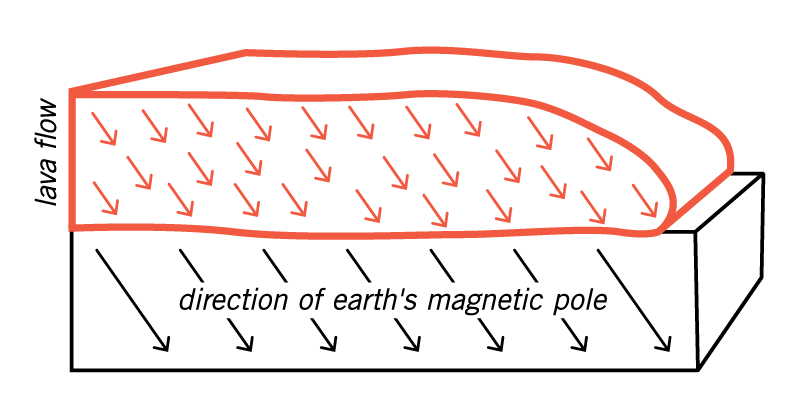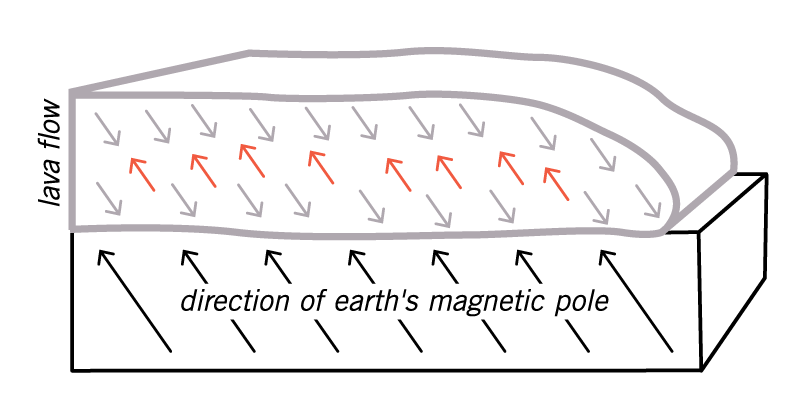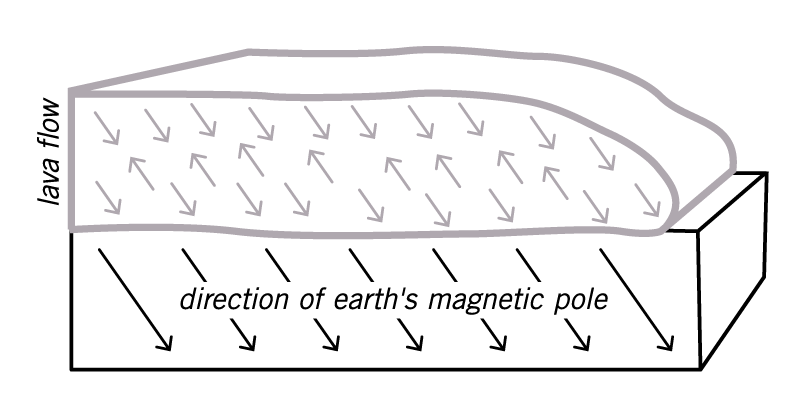
Creationists’ Power to Predict
Since the beginning of modern science, creationists have strived to explain our world based on the unchanging laws of our Creator. They continue to make uncanny predictions that defy evolution but align with observational science.
We rely on a dependable universe. From the cup of coffee sputtering out of our coffee maker to the engine rumbling in our SUV, we trust the ever-present laws behind our reality to keep on working. Even if we haven’t seen a chemistry formula or physics equation since high school, we enjoy their benefits. All these laws explain why our smartphones are smart and popcorn pops.
Some of us may not understand the scientific properties that make our world work, but we still know we can depend on them. When we wake up each morning, we have a good idea what’s coming next. After all, the faithful One who created the universe sustains it “by the word of His power”—from water to gravity, from stars to atomic forces (Hebrews 1:3). The laws reflect God’s character. Because He doesn’t change, the laws that keep our universe going don’t change either. He’s the reason our water heaters churn out hot water and the earth keeps spinning on its axis.
Those consistent laws allow us to make predictions about the universe. Life is like a big jigsaw puzzle, with a pile of jumbled pieces that entice us to put them together. The Creator wants us to recognize patterns and begin making connections between the pieces. Once we find the borders and start matching similar colors and patterns, we start to see the final image that glorifies Him.
Early scientists, such as Johannes Kepler and Isaac Newton, held this view; and it helped them lift Western Europe out of superstition. They understood that many pieces of the scientific puzzle are found only in Scripture—including God’s recent creation of the planets and His one-time global Flood judgment. Using the Bible as their framework, these scientists developed mathematically precise hypotheses that could produce testable predictions. The success of their predictions, even though they ran counter to popular expectations, established the viability of their theories.
Modern creationist researchers continue to develop new models to make sense of the universe and test new hypotheses based on the truths of the Bible. These models can be tested and verified. When verified, they testify to the power of the biblical worldview to help scientists find patterns that they might otherwise miss. Creationists have made several successful scientific predictions over the past few decades, but a few stand out for their precision and accuracy.
Earth’s Magnetic Personality
As a physicist working for Sandia National Laboratories, Russ Humphreys predicted that scientists would find evidence of a series of rapid reversals in the earth’s magnetic field during the Flood. Two years after his prediction, they found the evidence.
Field:
Physics
Prediction:
Rapid Reversal of Earth’s Magnetic Field
You’ve probably seen news reports showing how computer models have solved all sorts of scientific mysteries. A great number of silicon chips go into crunching numbers to figure out whether the next El Niño weather pattern will cause another drought in California or where the next hurricane will strike. All of this theorizing helps us understand the world around us—and even helps us know whether to take an umbrella to work.
But computer models help only when they accurately reflect reality. If a computer spends hours churning through numbers but spits out results that don’t take into account all the relevant facts, well, then the model needs revision. Often, the starting assumptions are wrong. After all, computers only work with the rules programmed into them.
Scientists have had a particularly difficult time developing a reliable model that accurately explains how the earth’s metallic core could produce a strong magnetic field that could last for millions of years. (This field is the invisible, life-saving barrier that keeps solar winds from stripping away our atmosphere’s ozone.) Batteries normally run down over time. So evolutionary scientists theorized years ago that some sort of self-sustaining generator, called a dynamo, keeps it going. They believe the core’s rotation returns much of the magnetic field’s lost energy back to the field.
For decades, scientists have been trying to make their models line up with observed measurements of the earth’s magnetic field. But they have not yet been completely successful.
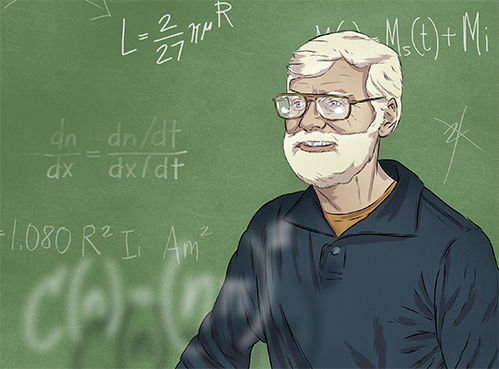
Illustration by John Phillips
Russ Humphreys
In the early 1980s Dr. D. Russell Humphreys, a physicist working at Sandia National Laboratories, developed a model very different from the dynamo theory. No one questions the scientific skills of this affable man with a full beard, winsome smile, and a twinkle in his deep blue eyes. He was an atheist before going to grad school. But after he received Jesus Christ as his Savior, he was driven to rethink the long-ages assumptions in his field, and consider them from a biblical basis.
If the earth is only thousands of years old, he surmised, its magnetic field could be generated simply by normal, freely decaying electric currents. This concept is well understood in physics and was proposed in the 1800s. But scientists ultimately rejected it simply because it would not explain a field that lasted for millions of years. Their old-earth bias got in the way of their science.
Dr. Humphreys hypothesized that God created the earth from water only a few thousand years ago, and that He aligned the slight electric charges of the original water molecules so that their magnetic field would jumpstart electrons in the earth’s core, producing the earth’s magnetic field. Much like the fully charged battery in your cell phone, the energy of this field began fully charged, but over time the energy slowly trickles out.
Where things get even more electric is during the Flood. In a scientific paper published in 1986, Humphreys proposed that circulation in the mantle at the beginning of the Flood started a series of rapid reversals in the earth’s magnetism. Under these circumstances, he predicted that new flips in the magnetic field would occur within a couple of weeks, not over thousands of years (as the dynamo theory requires).
He made a prediction: “The hypothesis is testable: one way would be to look for strata which clearly formed within a few weeks and yet contain at least one reversal. For example, we could look for distinct lava flows thin enough that they would have to cool below the Curie temperature (570°C) within a few weeks” (published in the 1986 Proceedings of the First International Conference on Creationism, pp. 113–126).
This prediction is remarkable because it is extremely specific. Geologists needed to find a place where lava had flowed onto the earth’s surface in a thin layer that could cool within two weeks. (Roughly 18 inches [46 cm] of basalt lava could cool this quickly.) Within molten lava, magnetic particles (like iron filings) would float freely enough to turn toward the magnetic north. Then, as the lava cooled, these magnetic particles would “freeze” in that position. If the magnetic pole flipped before the whole lava flow cooled, the magnetic particles in still-molten lava would turn around and point in the magnetic pole’s new direction. So, 18 inches of cold basalt with magnetic particles pointing in two opposite directions would suggest that the magnetic field reversed within two weeks.
Two years later, Humphreys’ prediction proved true!
In 1988, geologists working at Steens Mountain, Oregon, discovered evidence of a rapid reversal locked in after fewer than 15 days of cooling. This discovery stirred a controversy because it contradicted the predictions of prevailing theories. But more examples of rapid fluctuations have come to light since then, the most recent reported in 2014 from Italy’s Apennine Mountains. All of these evidences point to the accuracy of models built upon the biblical account.
This wasn’t Humphreys’ first successful magnetic field prediction. In 1984, he published a paper in which he assumed that the planets and their magnetic fields were created from water in the same way as the earth. In this paper he correctly predicted the magnetic field strength for both Uranus and Neptune, which Voyager 2 confirmed in 1986 and 1990 respectively. In the same 1984 paper and from the same model, Humphreys calculated the decay rate of Mercury’s magnetic field, and then predicted, “Mercury’s decay rate is so rapid that some future probe could detect it fairly soon” (Creation Research Society Quarterly, Winter issue, pp. 140–149). When Messenger zipped by in 2008, it discovered that Mercury’s field strength had decayed rapidly—as predicted—since the 1975 measurement by Mariner 10.
Rapid Radiohalos
A professional geologist from Australia, Andrew Snelling proposed that unique Flood conditions enabled polonium to decay in rocks and leave lots of scars, called radiohalos. He predicted that he could find these radiohalos, and he did.
Field:
Geology
Prediction:
Rapid Formation of Polonium Radiohalos
When most people think about mountains, they picture their favorite vacation spots, from the Smoky Mountains to Zion Canyon. But when geologists study mountains, they see more than just purple majesty and snow-capped wonders. They look deeper, trying to understand where the rocks came from, what they’re made of, and how they’ve changed. This isn’t just idle curiosity. Your ability to fill your car with affordable gasoline or to be warned of earthquakes depends on an army of professional rock-collectors.
Scientists have learned many things about the forces that reshape our planet, but some fundamental truths still remain a mystery. Many Christians have put on their field boots to pursue a career in geology—but not on the well-worn paths of evolution-based science. Instead, they start with the history revealed in Scripture, such as a global Flood. And they ask questions that other geologists never think to ask.
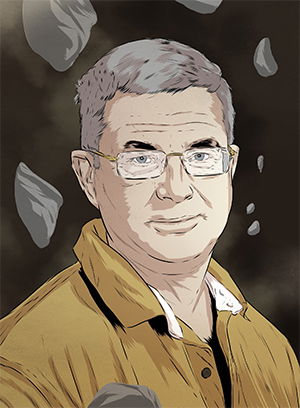
Illustration by John Phillips
Andrew Snelling
One such Christian is Dr. Andrew Snelling, an energetic and friendly Australian geologist who has loved to look at “hard rocks” ever since his father took him to a copper mine at age 9. Snelling’s interest often takes him to the laboratory, where he slices up rocks to examine them under a microscope. While this may sound tedious, he’s been rewarded by striking improvements in our understanding of the Flood’s catastrophic impact.
Thinking about how elements change over time, Snelling made one of the most profound predictions in the history of modern creation research. He put together several basic facts of rock chemistry—and added insights from Scripture that many of earth’s processes were accelerated during the Flood. You could think of it like a movie playing on fast forward.
Before we get to that, let’s consider what is known from rock research:
Uranium is an unstable radioactive element. In laboratories today, the most common form of uranium decays very slowly in a predictable way. During this “decay chain,” other fast-decaying elements, such as polonium, appear briefly—a blip on the radar, as it were.
As radioactive atoms decay, they shoot out millions of particles that damage the surrounding minerals. Since the particles shoot out in random directions, the radiation damage forms a sphere around the radioactive atoms. Viewed in cross section, the damage looks like a halo, which gives us the name “radioactive halo,” or radiohalo for short.
We find not just radiohalos made from uranium but other types of radiohalos nearby, including those formed by the decay of polonium. That’s a problem. Polonium, which forms by the decay of uranium, lasts only a short time before it’s gone. Yet the rock record reveals both uranium and polonium radiohalos near each other—frozen in time. How can polonium separate itself from the uranium before the polonium decays?
Snelling believed that special conditions during the Flood would explain this strange phenomenon in granites. (Granites form from magma as it rises near the earth’s surface and then cools.) If true, these conditions provide rock-solid evidence that many physical processes sped up during the Flood.
If large volumes of hot water seeped rapidly enough through uranium-bearing granite as it formed, then this water would carry the polonium away from the uranium before the polonium decayed.
The magma that originally formed the uranium-bearing granite was initially a scorching 1200–1330°F (650–705°C). Since radiohalos break down at temperatures above 302°F (150°C), the granite would have to cool within two weeks, not millions of years. Otherwise, we would not see radiohalos in the present.
In 2003, Snelling published his findings and proposed his model for the rapid water transport of polonium (see Proceedings of the Fifth International Conference on Creationism, pp. 243–267). In 2008 he continued to chip away at the problem and added the expectation of rapid cooling of the granite.
He then went a step further and applied his model to another type of rock. In a 2008 paper, Snelling predicted that polonium radiohalos should also be found in certain sedimentary rocks that were transformed when the earth’s plates crashed together during the Flood. At the right pressure and temperature, chemical reactions would release enough water to transport polonium away from uranium. He predicted that radiohalos would be most frequent at this pressure and temperature, and decrease in frequency away from this point.
Later in 2008 Snelling identified a spot in the Great Smoky Mountains, near Cherokee, North Carolina, where colliding plates produced just the right conditions. Better yet, the sandstone there contained minerals that could preserve any radiohalos that had been produced. Additionally, the sandstone was thick enough to allow him to gather other samples a great distance away where conditions wouldn’t have been as favorable. When he extracted minerals and examined them under a microscope, the highest frequency of polonium radiohalos came from places where the earth’s collisions generated the greatest volume of water, as expected.
No one had predicted anything like this before because it did not fit conventional evolutionary assumptions. Confirmation of Snelling’s prediction not only verified his model for the rapid formation of polonium radiohalos, but it also indicated that the sandstones must have been changed (metamorphosed) within two weeks during the Flood, not over millions of years.
Answers Magazine
January–March 2016
Discover the role of ancient Near Eastern writings in understanding Scripture and learn about some exotic animals that can only be explained by a Creator.
Browse IssueRecommended Resources

Answers in Genesis is an apologetics ministry, dedicated to helping Christians defend their faith and proclaim the good news of Jesus Christ.
- Customer Service 800.778.3390
- Available Monday–Friday | 9 AM–5 PM ET
- © 2026 Answers in Genesis


